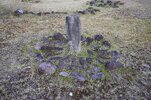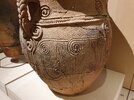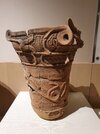Raoulfrkannon
The Force is Strong With This One
Recently I visited an archaeology museum containing pottery from the Jomon Period of the island of Japan, which runs from the deluge 12000 years ago to ~300BCE, followed by the Yayoi (300BCE-300CE) and Kofun (300-500CE) periods.
Before the photos, a little information about these cultures that leads to the questions I'd like to ask:
Jomon
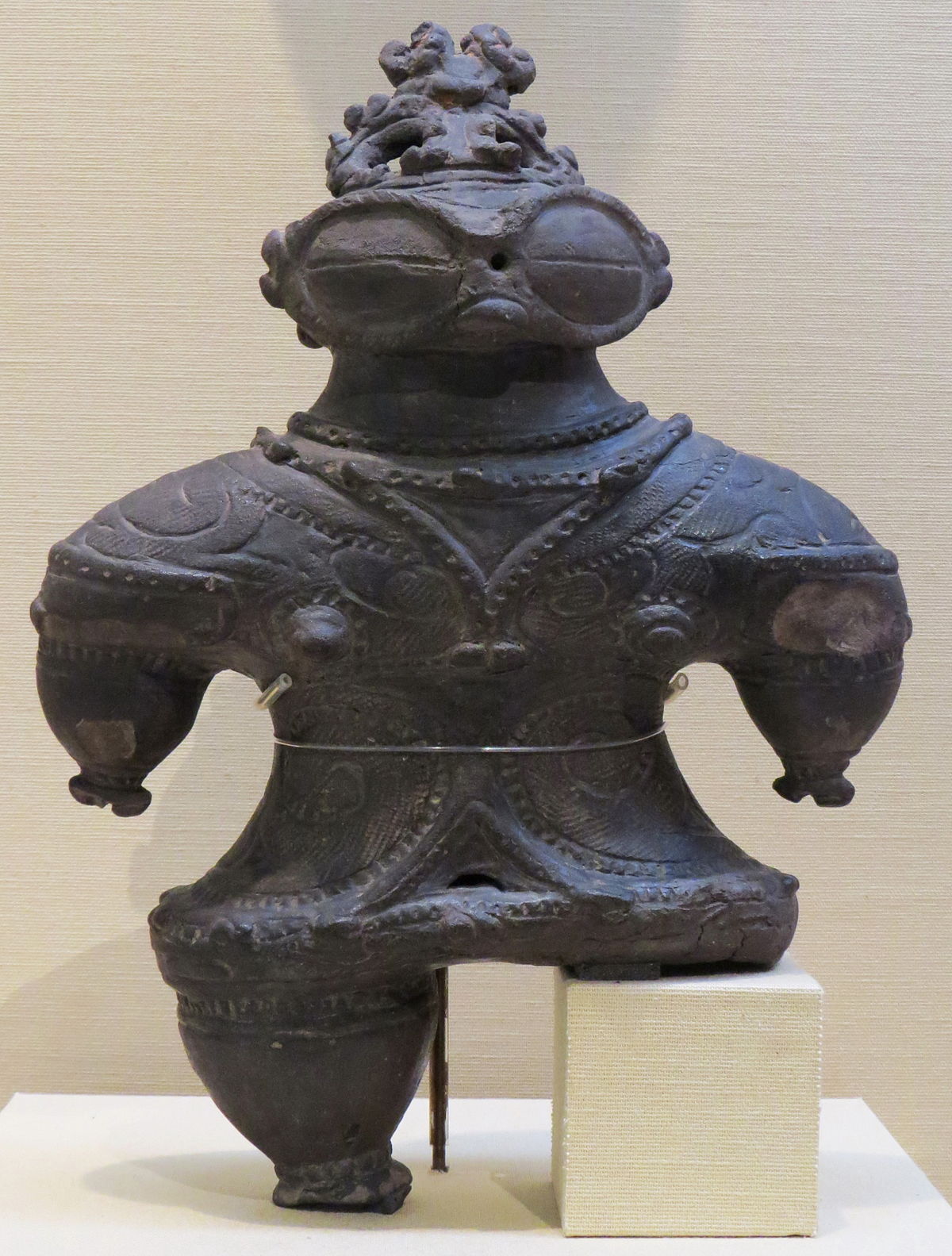
 en.wikipedia.org
en.wikipedia.org
Jomon ends and is replaced by the Yayoi (300BCE-300CE)
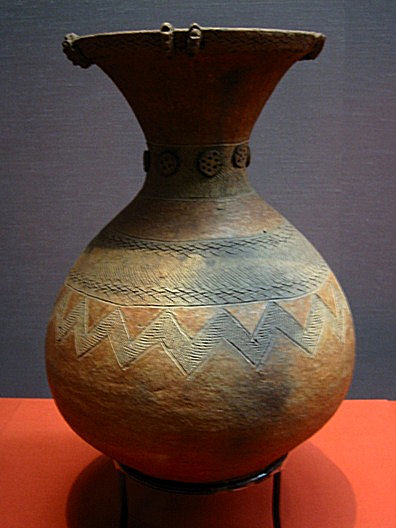
 en.wikipedia.org
en.wikipedia.org
Which in turn is superseded by the Kofun (300-500CE)
Nevertheless, there are still the later Emishi: Emishi - Wikipedia
.And nowadays the Ainu remain Ainu people - Wikipedia
So that's the bare bones of some background.
Now, the C's have mentioned Japan just a few times, two of them being:
And not only are there these strange structures underwater, but also megalithic arrangements still available across the country as in Europe. The most absolutely bonkers one is this giant temple of huge rocks arranged on the top of a 2599m high mountain called Mt. Kinpu:

So the crystal making Atlanteans were in the area pre-deluge, and probably the Jomon people were a set of survivors (or maybe even before the catastrophes - remember some of the same style pottery goes back pre-collapse of Atlantis! Though of course it changes over the thousands of years too).
Given how likely it is that the Jomon people later become the Emishi, Ainu, and other now extinct groups distinct from the Japaonic peoples, maybe they were a group of survivors from the northern Kantekkian part, others of which went to Europe instead, given the circles, spirals, and stones. It is especially interesting how the original language apparently belongs to its own linguistic family. A lot of modern Japanese words are Chinese, but there is a subset of Japanese called Yamatokotoba which are all the words pre-Chinese import. There is still a tradition of writing poetry only using Yamatokotoba, and I have read they feel quite different, though not being a native speaker I'm not sure how, but at the least a great Yamatokotoba word is for the rays of sunlight coming through trees: Komorebi. (My favourite linguistic irony is that the official way to refer to Yamatokotoba is actually with the Chinese pronunciation of the two assigned kanji, "Wago").
And yet! even Yamatokotoba are still only from Old Japanese, so it's unlikely that even that is what the Jomon people spoke (they never wrote anything down, having an oral tradition much like the Celts). Especially since Yamato period (which lends its name to this pre-Chinese language) actually starts with the Kofuns, so probably the language of the Jomon is something even more different! After all, the language of the Ainu belongs itself to its own linguistic family too! It's more likely that Jomon people spoke something like the Ainu language, and that current Chinese influenced Japanese is then twice removed (one by the Chinese effect, and two that even the non-Chinese oral Yamato language is still late on the scene).
So, now with a little background of how different the Jomon people were, here are some photos I took of some of the pottery they made:
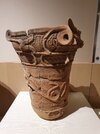
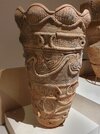
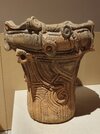
One of the things that always struck me when seeing pictures of Jomon pottery was, except for in some upper bands near the rim, the complete lack of symmetry. Seeing them in person, they are even more impressive in design, not to mention their sheer presence (the area of the room they were in felt completely different to the rest of the room occupied by the much "nicer" Yayoi and Kofun stuff). I spent some time trying to discern some symmetry, but if I would fixate on one thing as potentially repeating, and follow it, I would always encounter some novelty that would throw it off. Here's one in particular that seemed promising at first, front view, left view, and right, so you can see what I mean.


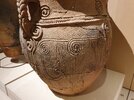
So symmetry makes me think of mirrors, and for some reason I couldn't shake the feeling of connection between this issue with the Jomon pottery, and the following exchange with Ark about the [penitent-avian-lord-templar-carrier] Etruscans:
If the Etruscans existed in such a metaphysically different way to others that their alphabet was literally mirrored in comparison, it makes me wonder about the Jomon people, whose pottery exhibits such uniqueness. My hunch is that, at the absolute least, their culture involved aesthetic principles against repetition (think of the danger of repetition, like in Gurdjieff/Mouravieff and the rule of seven which creates loops, along with cycles of addiction, 353535, numerology of 9 etc.) in favour of freedom and a kind of adroit command of the creation of novelty. But I reckon there is more than this.
Last night, I was scanning the transcripts for unrelated things, and encountered this for the first time:
So I went and looked up some such photos:
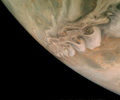
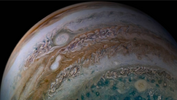
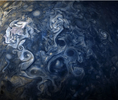
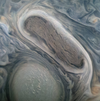
Is it just me or are the flowing strange patterns on Jupiter strangely reminiscent of the Jomon pottery?
Add to this the following exchange:
And also:
And I'm wondering the following:
Were the Jomon people a diverse yet united group similar to Egypt pre-Hermes? (perhaps including some Kantekkian-Atlantean survivors?)
Were they engaged in these bidensity interactions?
and
Is their pottery actually based on engagement with a higher level of density, just an aesthetic style, or something else?
Thanks as always.
Before the photos, a little information about these cultures that leads to the questions I'd like to ask:
Jomon
Jōmon period - Wikipedia
- Heterogenenous population belonging to common culture
- Hunter-gatherers
- Oldest known pottery created by impressing cords onto the clay ("Jomon" means cord-marked. It's interesting that they should be named for the way to create with clay, because in my opinion the Greeks called the Gaulish barbarians Keltoi because of stone carving - Ancient Greek χηλή, chele, meaning "crab pincers" is the root for Keloid scarring, although that's just my opinion.)
- I said from the deluge but actually Jomon classified pottery has been found dated to 14,500BCE, which is pre-catastrophes!
- Although hunter-gatherer, seems to have some cultivation of trees (soybean, azuki, hemp, etc.)
- "The genetic evidence suggests that an East Asian source population, near the Himalayan mountain range contributed ancestry to the Jōmon period population of Japan, and less to ancient Southeast Asians. The authors concluded that this points to an inland migration through southern or central China towards Japan during the Paleolithic. Another ancestry component seem to have arrived from Siberia into Hokkaido" (There is a lot more info on the genetics but I don't have much knowledge in that area yet)
- It's important to remember that this is a really long running period with a lot of changes, for example around 1000BCE, scholarly said to be still Jomon but late, magatama beads and burial mounds start appearing (Magatama - Wikipedia)
Jomon ends and is replaced by the Yayoi (300BCE-300CE)
Yayoi period - Wikipedia
- Farming culture
- Transition from neollithic through bronze to start of iron ages.
- Some argue it started 1000BCE, aformenetioned magatama beads and burial stuff probably belongs properly to this culture not Jomon peoples.
- With agriculture comes more complex settlements, wealth, land ownersihp arises, you know the drill
- "Direct comparisons between Jōmon and Yayoi skeletons show that the two peoples are noticeably distinguishable."
- "By the Kofun period, almost all skeletons excavated in Japan except those of the Ainu are of the Yayoi type with some having small Jomon admixture, resembling those of modern-day Japanese."
- Most likely comes from Korean and Chinese immigration
- Note that around 1000BCE the Zhou dynasty, whose culture included the idea they had a religious compact with their god, a mandate from heaven, starts in China
Which in turn is superseded by the Kofun (300-500CE)
- Aristocratic society with militaristic rulers develops
- Divine emperor
- Brings in Chinese writing system and really awkwardly applies it onto the Japanese language
- Leads to introduction of Buddhism
- Even greater influence from China and Kora
- Introduction of keyhole-shaped burial mounds called kofun, some of which over 400m long. (Similar cult of the dead to Egypt?)
Nevertheless, there are still the later Emishi: Emishi - Wikipedia
- Referred to by the Chinese as "hairy people" living in Japan
- Lived mainly in the north and resisted the southern Asian peoples fwho were expanding from Kofun period onwards
- Masters of hit-and-run tactics using horse archery (Scythians anyone?)
- Still based on hunter-gathering but with some cultivation like rice and millet
- Several historians find links between them and Tungisic peoples of Siberia and Northeast Asia
- Suppressed or eliminated by the Japanese
.And nowadays the Ainu remain Ainu people - Wikipedia
- Have their own language and culture distinct from Japanese
- Traditionally hunter-gatherers
- Religion based on nature
- Been around long before the Japonic populations, forced up into Hokkaido and culture and language suppressed
- A lot of facial features more similar to European type (look at some of the pictures on the wiki article)
- A lot of genome stuff that again I'm not in a position to explain well at the moment
- Culture incorporates a lot of spiral and meander patterns
So that's the bare bones of some background.
Now, the C's have mentioned Japan just a few times, two of them being:
August 15th 1998
Q: (L) I have tried to imagine a plane full of pure Aryan types, or purified Celts, and it is difficult to imagine what such a culture would be like. Is there anything that we can look at, literary or otherwise, that would give me a concept of what this culture or society could have been like?
A: Search Japan and the Bahamas.
November 19th 1994
Q: (L) Besides the crystal in the Bermuda Triangle, are any of the others still active?
A: Yes.
Q: (L) Where are the others located?
A: Off Japan; in Brazil; in Ural mountains of Russia; North and South Poles.
And not only are there these strange structures underwater, but also megalithic arrangements still available across the country as in Europe. The most absolutely bonkers one is this giant temple of huge rocks arranged on the top of a 2599m high mountain called Mt. Kinpu:

So the crystal making Atlanteans were in the area pre-deluge, and probably the Jomon people were a set of survivors (or maybe even before the catastrophes - remember some of the same style pottery goes back pre-collapse of Atlantis! Though of course it changes over the thousands of years too).
Given how likely it is that the Jomon people later become the Emishi, Ainu, and other now extinct groups distinct from the Japaonic peoples, maybe they were a group of survivors from the northern Kantekkian part, others of which went to Europe instead, given the circles, spirals, and stones. It is especially interesting how the original language apparently belongs to its own linguistic family. A lot of modern Japanese words are Chinese, but there is a subset of Japanese called Yamatokotoba which are all the words pre-Chinese import. There is still a tradition of writing poetry only using Yamatokotoba, and I have read they feel quite different, though not being a native speaker I'm not sure how, but at the least a great Yamatokotoba word is for the rays of sunlight coming through trees: Komorebi. (My favourite linguistic irony is that the official way to refer to Yamatokotoba is actually with the Chinese pronunciation of the two assigned kanji, "Wago").
And yet! even Yamatokotoba are still only from Old Japanese, so it's unlikely that even that is what the Jomon people spoke (they never wrote anything down, having an oral tradition much like the Celts). Especially since Yamato period (which lends its name to this pre-Chinese language) actually starts with the Kofuns, so probably the language of the Jomon is something even more different! After all, the language of the Ainu belongs itself to its own linguistic family too! It's more likely that Jomon people spoke something like the Ainu language, and that current Chinese influenced Japanese is then twice removed (one by the Chinese effect, and two that even the non-Chinese oral Yamato language is still late on the scene).
So, now with a little background of how different the Jomon people were, here are some photos I took of some of the pottery they made:



One of the things that always struck me when seeing pictures of Jomon pottery was, except for in some upper bands near the rim, the complete lack of symmetry. Seeing them in person, they are even more impressive in design, not to mention their sheer presence (the area of the room they were in felt completely different to the rest of the room occupied by the much "nicer" Yayoi and Kofun stuff). I spent some time trying to discern some symmetry, but if I would fixate on one thing as potentially repeating, and follow it, I would always encounter some novelty that would throw it off. Here's one in particular that seemed promising at first, front view, left view, and right, so you can see what I mean.



So symmetry makes me think of mirrors, and for some reason I couldn't shake the feeling of connection between this issue with the Jomon pottery, and the following exchange with Ark about the [penitent-avian-lord-templar-carrier] Etruscans:
August 16th 1997
Q: Ark suggested that the Etruscans may have gotten their alphabet as a mirror image. Could it be that they lived on the 'other side' of the mirror?
A: Latter is closer.
If the Etruscans existed in such a metaphysically different way to others that their alphabet was literally mirrored in comparison, it makes me wonder about the Jomon people, whose pottery exhibits such uniqueness. My hunch is that, at the absolute least, their culture involved aesthetic principles against repetition (think of the danger of repetition, like in Gurdjieff/Mouravieff and the rule of seven which creates loops, along with cycles of addiction, 353535, numerology of 9 etc.) in favour of freedom and a kind of adroit command of the creation of novelty. But I reckon there is more than this.
Last night, I was scanning the transcripts for unrelated things, and encountered this for the first time:
December 12th 1995
A: If that is what they are saying , but remember, Jupiter, Saturn and others resonate to vibrational levels greater than Earth. You are looking directly at density 4 when you view Jupiter, which is why photos of it from up close appear "surreal," more like drawings.
So I went and looked up some such photos:




Is it just me or are the flowing strange patterns on Jupiter strangely reminiscent of the Jomon pottery?
Add to this the following exchange:
August 20th 2001
Q: I'm getting the feeling that there have been bleed-in, bleed-out situations with 4th density on this planet a lot more often than we suspect.
A: Yes.
And also:
October 16th 1994
Q: (L) Who was Hermes Trismegistus?
A: Traitor to court of Pharoah Rana.
Q: (L) Who is Pharoah Rana?
A: Egyptian leader of spiritual covenant.
Q: (L) In what way was Hermes a traitor?
A: Broke covenant; he inspired divisions within ranks of Egyptians, Essenes, Aryans, and Persians et cetera.
And I'm wondering the following:
Were the Jomon people a diverse yet united group similar to Egypt pre-Hermes? (perhaps including some Kantekkian-Atlantean survivors?)
Were they engaged in these bidensity interactions?
and
Is their pottery actually based on engagement with a higher level of density, just an aesthetic style, or something else?
Thanks as always.

